Setting rafters, as well as the creation of the whole roof, a very responsible process. Taking into account the fact that the root base can be fastened to the wall using the submitted tools for lifting, the subsequent work on its creation, which includes and installing the rafted, it will be impossible without a forest device that includes mobile structures. Forests are used to raise materials to the desired height, in addition, they can be applied as a work area for a person and place for laying building materials.
The device of the rafter system.
Preparation of forests and scaffolding
Installing rafters with your own hands may seem very laborious, but if you adhere to all tips and perform them correctly, the process will be fascinating. If you build a house, it is necessary to use at least 3rd forests, in any case, their number should not be less than 2. To work it is better to make mobile forests, as they are very comfortable. Installation of the rafter should begin only after all security issues are solved, in no case should not be neglecting it, since health is more important than the speed of construction.
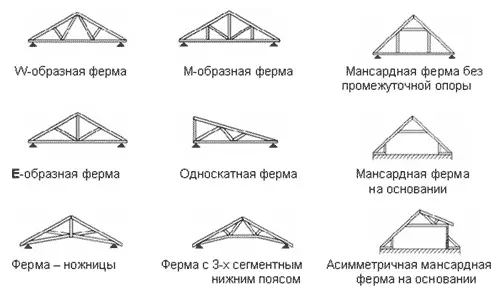
Types of rafter systems.
If there is no internal bearing wall in the house, then there is no additional support, and the building legs are observed only on the outer walls of the house, in which case you need to use hanging rafters.
What is rafters? Translated from the ancient Russian language is a design to support a duplex roof. And the rafting legs are inclined, with which the roofing rod is formed. Stropile legs are usually connected by "grandmas" or "lumps", which are made vertically. The tightening is a horizontal bar, with its help the rafter feet are connected.
Varieties of construction crop
Roofing structures, as a rule, contain the following components:
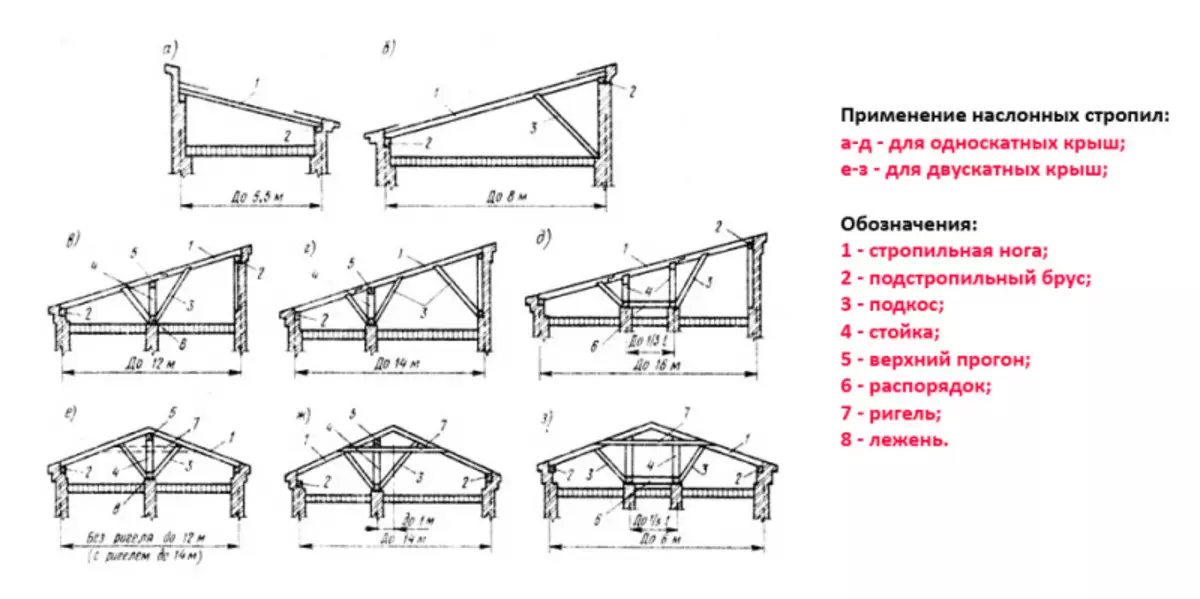
Schemes of the sling and their application.
- For the formation of slope uses rafting legs.
- To transfer part of the load - columns or internal backups.
- Various inclined elements (pumps, disclosures) that perform the same functions as the rack.
- Elements that fasten with a friend of the rafting legs. Usually, overlapping beams are used for this.
Article on the topic: Ready ideas of living room design with fireplace and TV
The triangle is the optimal shape of the rafter farm. This design has the greatest rigidity.
Despite the many possible molds of the roof, two types of device rafters are usually used:
- Sloper system;
- Hanging rafters.
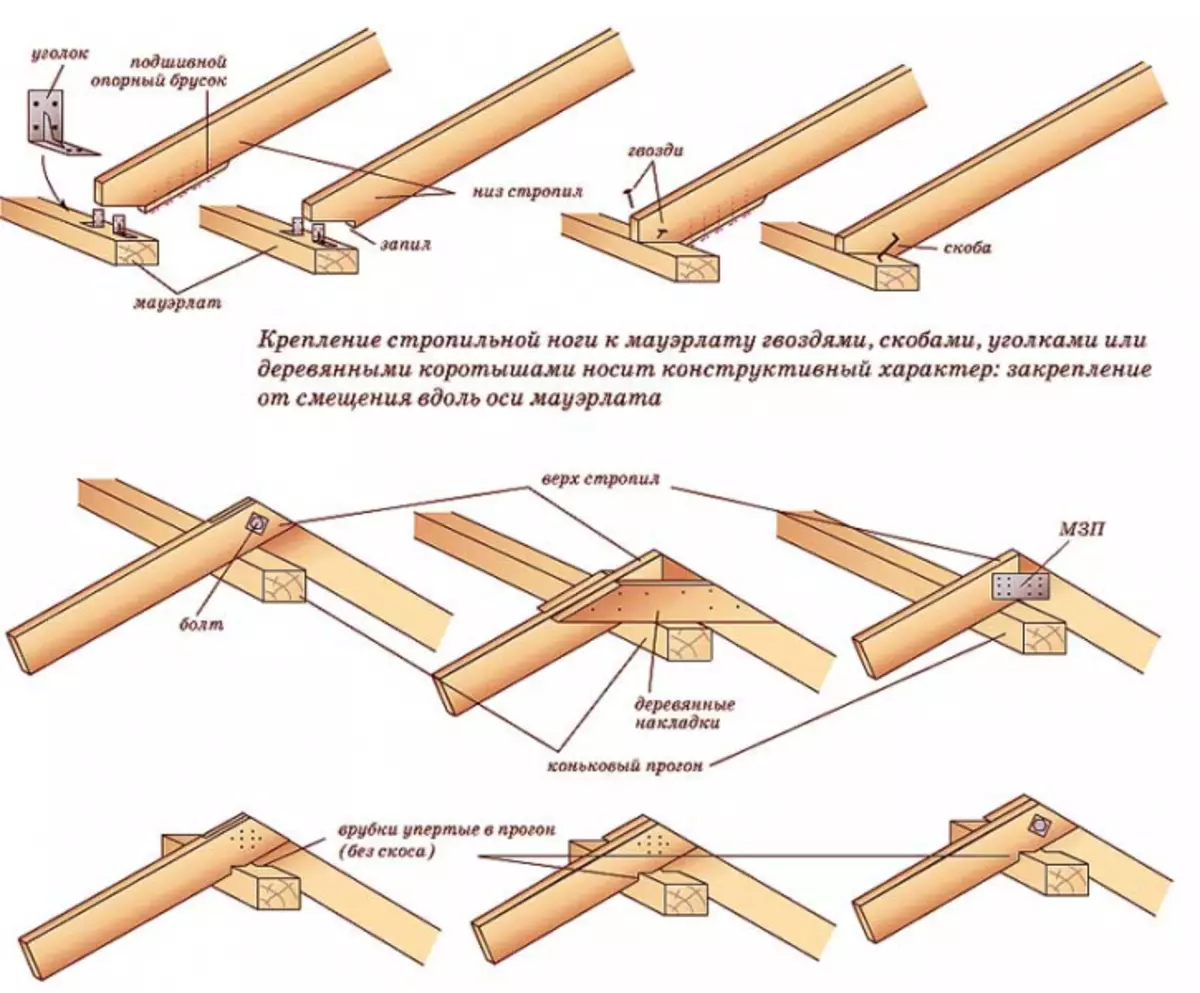
Figure 1. Installation of rafters.
The first case is used under the condition of the presence in the construction of the building of the internal bearing elements. At the same time, the rafter legs are emphasis not only on the outer walls, but also on the inner columns or supports. For the transfer of the load, racks are used. Figure 1 shows the scheme of mounting rafters.
Hanging design has focus only on the outer walls, and in the skate, the rafters are based on each other. Hanging rafters are used in the absence of intermediate supports, the width of the span is less than 12 m. A feature of the design is a high position of the spacer load, to reduce it use special tightening. The legs of such a rafter system should be strengthened using a sub-vehicle, which will also reduce the pressure on the bearing walls.
Walls made of brick or stone require mauelalat installation. Mauerlat is a wooden bar, which usually has a 150x150 mm cross section and is fixed with special studs. These studs must be in advance in the wall. Under Maurylalat, a waterproofing layer is necessarily placed.
Installation of hanging rafters on Mauerlat do it yourself: Step by step instructions
The following tools will be needed for work:
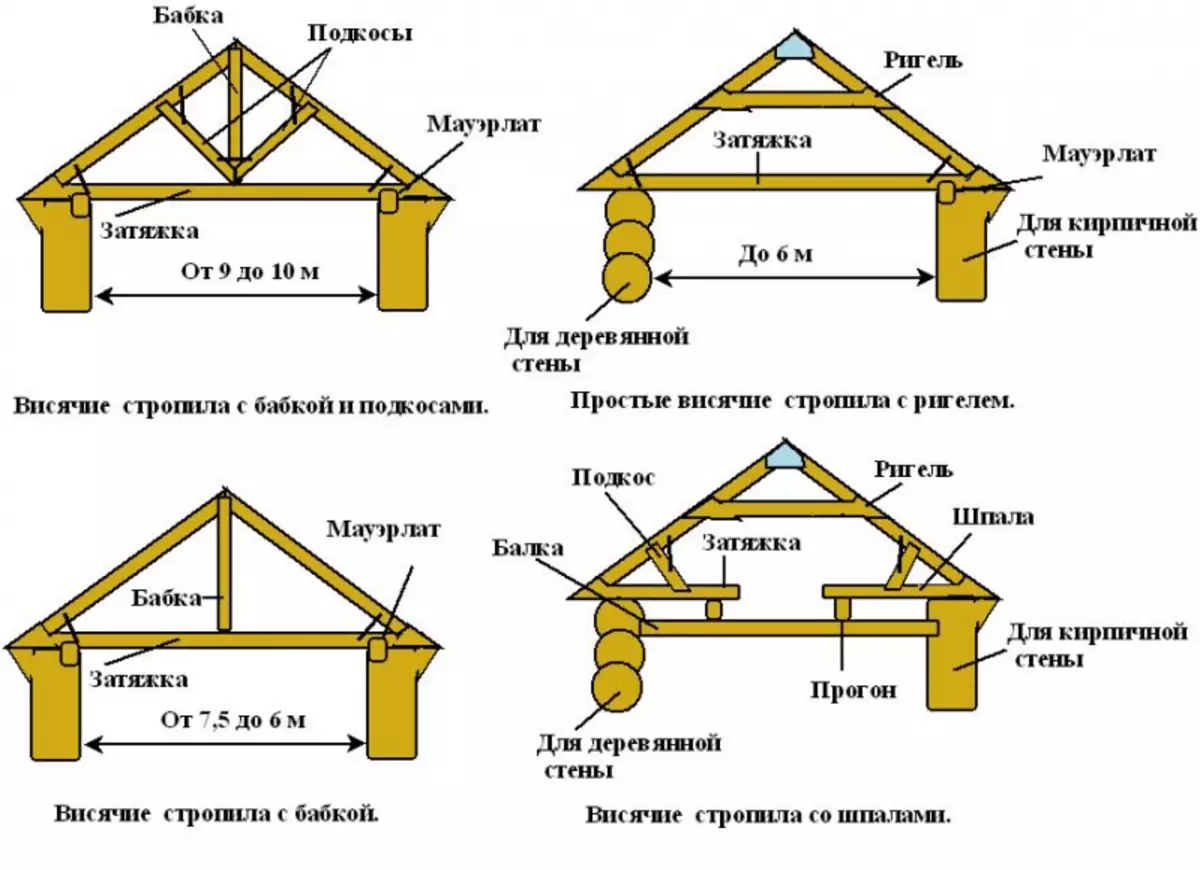
Scheme and installation of hanging rafters.
- ax;
- a hammer;
- a knife for accurate fittings;
- pencil;
- plumb;
- roulette;
- building level.
To install the rafter, it is necessary to take a timber, the length of which will be 6 m, and the cross section is 50x200 mm. It should be noted that if suddenly the cross section is small, then after some time, such a design can be saved. Based on the case described above, the roof slide, namely its angle, should be 33 º. The next installation step rafter is that, applying forests, you need to raise 2 timber and connect them upstairs.
Article on the topic: How best to make the ceiling
The following works are performed:
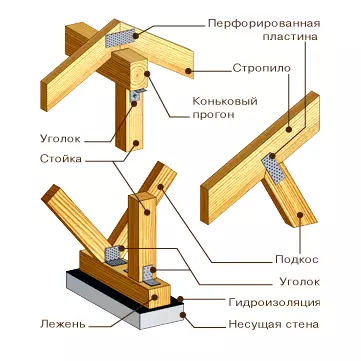
Knots of spots rafters.
- On the rafter feet you need to "stroke the heel" in the following way, so that the rafter to the Maurylalat relieves well.
- With the next rafter, you need to do the same. It will be nice if the rafting legs will be labeled as "left" and "right".
- After performing these works, the rafter legs must be connected.
- After that, on the spot where the rafting legs are connected, you need to perform with the right angle of "Penc", in order for rafters at the top not to be connected to the penetration, and then fastened with nails. This method is unreliable, since rafters overtake each other.
- To properly execute "hemp", it is necessary to initially attach one rafter to another, then draw the line of their connection (for this you can use a pencil) and then cut off.
- To prepare building material on Earth, you need to measure and make several templates at once.
- Having done all the operations, start the installation of the rafter first on one frontonone, and after another. Using nails, perform the mounting rafted to Mauerlat.
- The following pairs of rafter feet are prepared on ready-made templates on Earth;
- Then you need to pull the thread between the already ready-made pairs of rafters and proceed to the installation of all the remaining rafters.
- The distance on which rafters are installed is 70 cm. Of course, in fact, it may be within 68-73 cm from each other. This is considered the optimal distance for the roof, as it is reliable, and such a distance between the rafters will be convenient in the future when you pull the film.
- For these purposes, it is necessary to initially make the markup of Maurolalat, and then it is planted to install rafters.
- It is worth noting that the adjustment must always be carried out with the help of a thread, which is tensioning between the rafters, when necessary, it will be possible to adjust the height of the rafting legs. In some cases, you need to put small planks under your feet.
- Adjustment at the bottom in width, which is located between two rafters, is made according to the specified markup on the Mauerlat. As for the upper part, the adjustment is carried out using a temporary board with the same markup. This means that after each pair of rafters is installed, at the top to the left and right rafying, the board is nailed to the markup already made by the markup, which corresponds to the markup applied to Maurylalat.
- In the described case, the hanging rafters will need to be combined with a horizontal bar, that is, a tightening, due to a large distance between the supporting walls. It is worth paying attention to the fact that initially the rafter pairs were connected by a horizontal board in the area of the skate, forming the ski knot.
Article on the topic: Blinds for a gazebo: a variety of materials and mounting methods

Installation of a double roof.
In the case under consideration, due to the long distance between the carrier walls, where the width of the house itself is about 11 m, the tightening will consist not from one bar, and from several interconnected boards. Such a tightening made of several boards will help solve several tasks at once:
- As a result, it turns out a tightening of the desired length:
- It is worth noting that the strength and reliability of the tightening made of 3 boards with a cumulative thickness of 60 mm is much higher than if it is a single ram with a thickness of 60 mm.
High-quality roof: Summing up
For the required length, 4 and 6th boards were cut off, after which they were fastened with nails, knocked out nuts and studs with rapid legs.
Under the constant control, you need to keep the distance that is between the tighters. It should be the same with the fact that between rapid legs.
To do this, you need to apply narrow powder, as in the case of controlling the distance of rafter pairs in the skate, which are marked and correspond to the applied markup on the Mauerlate. You must always keep control of the distance!
In addition to all this, the tightening and horse were connected by another 1st board. Considering the fact that the retaining wall is absent, the tightening will simply progress, not to withstand its own weight. In order to avoid such troubles, the tightening together with the skate of the rafter pair is connected by the "grandmother". All the actions described above must be done with each rapid pair.
